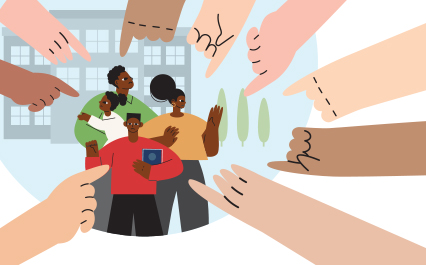Page Content

Racism against Black people is based on an unjust social order that affects all Black people as a collective. Anti-Black actions perpetuating racism fall across a boundless spectrum.
THE FOLLOWING IS A LIST OF SPECTRUMS FROM THE LEAST TO MOST OBSERVABLE / RECOGNIZABLE.
1 Tropes
Embellishing or using clichéd descriptions that create imagery based on a Black racialized stereotype. Many tropes create a segregated mentality or a sense of Black people being the “other.”
Examples
- Black students viewed as immigrants and refugees from a “third world country”
- Black families are poverty stricken, needy and struggling
- Black female teachers are aggressive and respond with anger
- Black males are excellent athletes, disinterested in academics, disruptors in the classroom
- Groups of Black students are excessively loud or belong to gangs
2 Tokenism
Deliberately recruiting and using members from the Black community to prevent criticisms of lack of racial diversity. This is a covert act of racism, as power is retained by the privileged group.
Examples
- Treating Black people as monoliths or representatives for an entire race
- Expecting Black teachers to lead racial diversity initiatives
- Identifying Black students to play on sports teams, perform rap music or sing in choirs
- Displaying generosity toward Black students as an act of charity
- Singling out Black students for being late or absent
3 Cultural appropriation
Copying elements of Black culture for trivial reasons. Not simply “borrowing” from Black or other racial cultures, but perpetuating negative stereotypes.
Examples
- Use of Black or Brown face
- Dressing in Halloween costumes portraying Black celebrities or historical figures
- “Blackfishing”: wearing Black hairstyles like dreadlocks, cornrows, box braids or adopting Black features through tanning or body fillers
- Asking Black communities to tolerate and normalize appropriation as a compliment to their culture
4 Assimilation
Deconstructing Black identity by expecting or forcing Black people to adopt the values, behaviours, culture and social norms of the dominant group.
Examples
- Lack of understanding of the importance of maintaining Black culture
- Grouping all Black people as the same without acknowledging the unique cultures within the Black community
- Believing that Black students/teachers have an opinion on race while disregarding it as an experience
- Poor pronunciation of Black students’ names or nicknaming a Black student for ease of pronunciation
- Disregarding and challenging cultural attire and headwear
- Assignments, classroom activities or teacher perspectives centered on the dominant race
5 Macroaggressions
Assaulting cultural identity through targeted indignities, shaming and dehumanizing behaviours based on reducing or marginalizing the Black individual.
Examples
- Unsolicited touching of body features (hair)
- Black jokes and other forms of racial humour
- Singling out individuals for belonging to the Black race
- Marginalized compliments (e.g., “You’re pretty for a Black girl,” “You are so articulate for a Black student,” “You are a credit to your race.”
- Disparaging comparisons to Black culture/people
- Denying the lived experiences of racism through “gaslighting” (e.g., “Did it really have to do with your race?” or “If you worked harder you would be successful.”)
- Statements of denial (e.g., “When I look at you, I don’t see colour,” or “I am not racist, I have several Black friends.”)
- Assuming that a Black person is a service worker
6 Implicit biases
Beliefs and attitudes that lack neutrality toward certain people or groups.
Examples
- Accepting discriminatory beliefs and racial misinformation
- Unprovoked suspicion and targeted blame toward Black people
- Social avoidance or discomfort around Black people
- Seeking out others with like-minded racial beliefs
- Ambivalence toward racism as nothing more than a social construct
7 Power and privilege
Denying responsibility for the dominant race’s repressive actions, beliefs or values. Feelings of guilt and shame related to discrimination against Black people are converted to benefit the dominant group.
Examples
- Feeling the need to “teach” people of other races the way to live or navigate life, as an act of saviourism
- Centering race conversations on your own personal feelings/experiences
- Benefitting from historical narratives and systemic processes that diminish Black people
- Inherently believing and trusting authority figures of the privileged race
- Subjectively determining what should be considered racist
- Believing that the wrongs of racism can be righted by being “colour blind” from now on
8 Fear of insurgency
Congregating or formal organization of Black people that provokes a biased fear of imminent racial hostility. Fear of insurgency is a response to being outnumbered by the racialized group.
Examples
- Treating groups of Black students with suspicion
- Subjecting Black students to higher levels of surveillance than other students
- Prohibiting Black students from gathering
- Filming interactions with Black people for one’s protection
- Through community-based or school-policing models, favouring punitive action over relationship-based outcomes with Black people
- Viewing peaceful demonstrations, marches and rallies as unlawful resistance
9 Acts of oppression
Applying cultural practices that reduce the power of Black people in favour of the dominant race by discriminating, disapproving, criticizing, and denying equity and human rights.
Examples
- Silencing advocates of anti-Black racism
- Language: use of the N-word, racial jokes
- Violence and threats through bullying/hazing or social media
- Harassing Black students based on discriminatory biases, such as believing that Black people are predisposed to misbehaviour, underachievement and promiscuity
- Misrepresenting Black people as threatening, violent, unlawful and felonious
- Rationalizing the use of deadly force against Black people.
